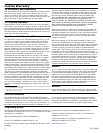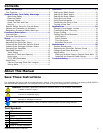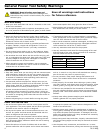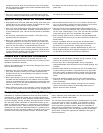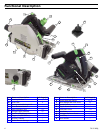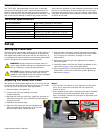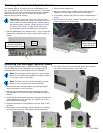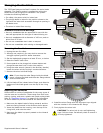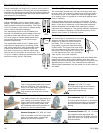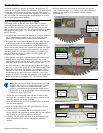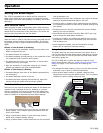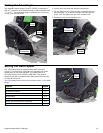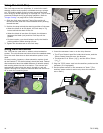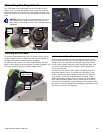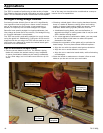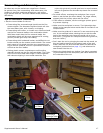
10 TS 55 REQ
Sawblade Selection
Festool sawblades are designed for optimal performance in
a variety of applications. Choosing the correct sawblade is
important for obtaining the best cuts and optimal blade life.
There are several factors that determine which blades are
best suited for the operation.
Tooth Shape
Festool sawblades come in two primary tooth
shapes. The Alternate Top Bevel (ATB) shape is
ideal for clean cutting of wood bers. The Triple
Chip (TC) shape is very robust in holding sharp-
ness in hard or abrasive materials.
The alternating points of the ATB blade slice
through the wood bers at the edges of the cut
to produce clean and efcient cuts. The lower
15° bevel angle of Festool blades allow them
to maintain sharpness of the points longer
between sharpenings.
The trapezoidal shape of the TC blade tooth
maintains its sharpness by not having points
that could quickly dull. Each trapezoidal tooth
initially cuts a little of the center of the cut,
and then is followed by a at-top raker tooth
to nish the cut and clean up the corners. The
TC grind is ideally suited for materials that would
otherwise quickly dull an ATB blade.
Number of Teeth and Spacing
The more teeth a blade has, the less work each tooth has
to do by itself. This results in cleaner cuts in brous materi-
als such as wood. It also makes the blade less aggressive
in its cutting, which is benecial in both hard materials and
brous materials.
Another aspect about tooth spacing is harmonics. If each
successive tooth strikes the workpiece in rhythm with other
teeth, it can set up vibrations in the blade and workpiece.
Festool sawblades use variable tooth spacing to prevent
harmonics from happening. The spacing between successive
teeth is constantly changing so that the frequency of suc-
cessive cuts is never in a harmful rhythm.
Hook Angle
The hook angle of a sawblade is the angle
between the face of a blade tooth with
respect to a radial line to the center of
the blade. This is most obvious on rip-
ping blades, where the high hook angle
is easily seen. The higher the hook angle,
the more aggressive the blade will cut the
workpiece. This is desired for ripping, but
it is not desired for ner cuts, and espe-
cially not for vary hard materials.
Cutting harder materials is best performed with blades with
lower hook angles. Metal cutting blades (and miter saw
blades) actually have negative hook angles to minimize their
aggressiveness in the cut. This means that the teeth are
sloped slightly backward from the radial line to the center of
the blade.
TS 55 REQ Sawblades
Fine Crosscut: 48T, ATB, 12° hook
This is the standard blade that comes
with the TS55 saw. The high tooth
count, low hook angle, and ATB design
make it optimally suited for cut-
ting veneered plywood with minimal
tearout.
Ripping: 14T, ATB, 37° hook
The high hook angle of the Panther
blade makes for effortless ripping
without burning the cut.
Combination: 28T, ATB, 15° hook
This blade combines the geometries of
both ripping and crosscut blades. The
higher hook angle makes it cut more
aggressive like a ripping blade, and
the moderate tooth count provides a
cleaner cut like a crosscut blade.
Fine Laminate: 48T, TC, 4° hook
The ultra-hard TCG teeth on this blade
provide chip-free cutting of laminates
and solid surface materials without
dulling.
General Purpose: 12T, ATB, 20° hook
With a low tooth count and a high hook
angle, this blade easily cuts through
general construction materials.
Aluminum/Plastic: 56T, TC, -5° hook
The negative hook angle and high
TCG tooth count of this blade provides
grab-free control for cutting aluminum
and hard plastic.
ATB
Bevel
TCG
Hook



